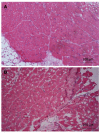Protection of the liver against CCl4-induced injury by intramuscular electrotransfer of a kallistatin-encoding plasmid
- PMID: 21218091
- PMCID: PMC3016670
- DOI: 10.3748/wjg.v17.i1.111
Protection of the liver against CCl4-induced injury by intramuscular electrotransfer of a kallistatin-encoding plasmid
Abstract
Aim: To investigate the effect of transgenic expression of kallistatin (Kal) on carbon tetrachloride (CCl(4))-induced liver injury by intramuscular (im) electrotransfer of a Kal-encoding plasmid formulated with poly-L-glutamate (PLG).
Methods: The pKal plasmid encoding Kal gene was formulated with PLG and electrotransferred into mice skeletal muscle before the administration of CCl4. The expression level of Kal was measured. The serum biomarker levels of alanine aminotransferase (ALT), aspartate aminotransferase (AST), malonyldialdehyde (MDA), and tumor necrosis factor (TNF)-α were monitored. The extent of CCl4-induced liver injury was analyzed histopathologically.
Results: The transgene of Kal was sufficiently expressed after an im injection of plasmid formulated with PLG followed by electroporation. In the Kal gene-transferred mice, protection against CCl4-induced liver injury was reflected by significantly decreased serum ALT, AST, MDA and TNF-α levels compared to those in control mice (P<0.01 to 0.05 in a dose-dependent manner). Histological observations also revealed that hepatocyte necrosis, hemorrhage, vacuolar change and hydropic degeneration were apparent in mice after CCl4 administration. In contrast, the damage was markedly attenuated in the Kal gene-transferred mice. The expression of hepatic fibrogenesis marker transforming growth factor-β1 was also reduced in the pKal transferred mice.
Conclusion: Intramuscular electrotransfer of plasmid pKal which was formulated with PLG significantly alleviated the CCl4-induced oxidative stress and inflammatory response, and reduced the liver damage in a mouse model.
Keywords: Drug formulation; Electroporation; Gene delivery systems; Kallistatin; Liver injury.
Figures





References
-
- Alberts B. The breakthroughs of 2009. Science. 2009;326:1589. - PubMed
-
- Bloquel C, Fabre E, Bureau MF, Scherman D. Plasmid DNA electrotransfer for intracellular and secreted proteins expression: new methodological developments and applications. J Gene Med. 2004;6 Suppl 1:S11–S23. - PubMed
-
- André FM, Gehl J, Sersa G, Préat V, Hojman P, Eriksen J, Golzio M, Cemazar M, Pavselj N, Rols MP, et al. Efficiency of high- and low-voltage pulse combinations for gene electrotransfer in muscle, liver, tumor, and skin. Hum Gene Ther. 2008;19:1261–1271. - PubMed
-
- Cukjati D, Batiuskaite D, André F, Miklavcic D, Mir LM. Real time electroporation control for accurate and safe in vivo non-viral gene therapy. Bioelectrochemistry. 2007;70:501–507. - PubMed
Publication types
MeSH terms
Substances
Grants and funding
LinkOut - more resources
Full Text Sources
Miscellaneous

